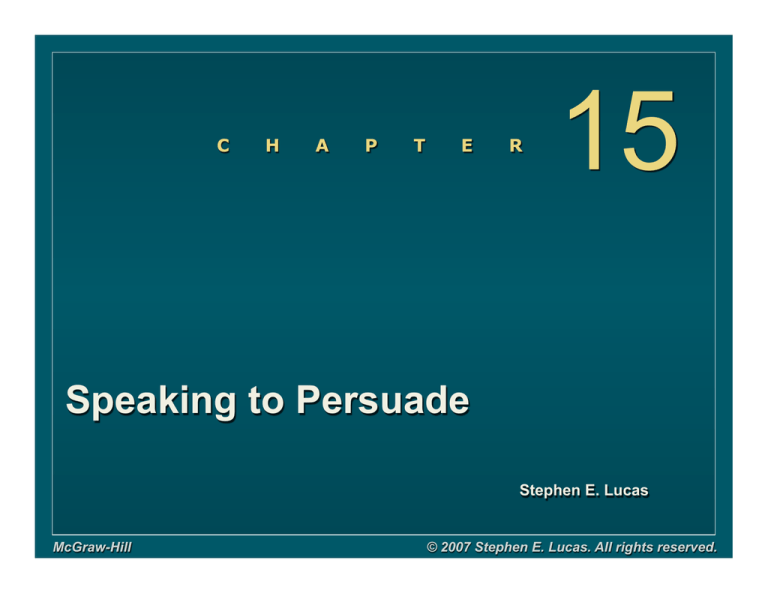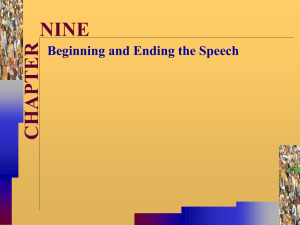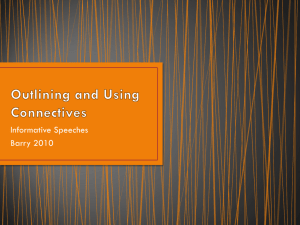
C
H
A
P
T
E
R
15
Speaking to Persuade
Stephen E. Lucas
McGraw-Hill
© 2007 Stephen E. Lucas. All rights reserved.
Slide 2
Persuasion
The process of creating, reinforcing, or
changing people's beliefs or actions.
McGraw-Hill
© 2007 Stephen E. Lucas. All rights reserved.
Slide 3
Ethics and Persuasion
• Make sure your goals are ethically
sound
• Use ethical methods to communicate
your ideas
McGraw-Hill
© 2007 Stephen E. Lucas. All rights reserved.
Slide 4
Degrees of Persuasion
Strongly
Opposed
Moderately
Opposed
Slightly
Opposed
Neutral
Slightly
in Favor
Moderately
in Favor
Strongly
in Favor
Persuasion involves any movement by a
listener from left to right
McGraw-Hill
© 2007 Stephen E. Lucas. All rights reserved.
Slide 5
Mental Dialogue with the
Audience
The mental give and take between
speaker and listener during a
persuasive speech.
McGraw-Hill
© 2007 Stephen E. Lucas. All rights reserved.
Slide 6
Target Audience
The portion of the whole audience that
the speaker most wants to persuade.
McGraw-Hill
© 2007 Stephen E. Lucas. All rights reserved.
Slide 7
Types of
Persuasive Speeches
• Speeches on questions of fact
• Speeches on questions of value
• Speeches on questions of policy
McGraw-Hill
© 2007 Stephen E. Lucas. All rights reserved.
Slide 8
Question of Fact
A question about the truth or falsity
of an assertion.
McGraw-Hill
© 2007 Stephen E. Lucas. All rights reserved.
Slide 9
Persuasive Speech on a
Question of Fact
Specific Purpose: To persuade my audience that an
earthquake of 9.0 or above on
the Richter scale will hit
California in the next ten years.
Main Points:
I.
California is long overdue for
a major earthquake.
II. Many geological signs
indicate that a major
earthquake may happen soon.
III. Experts agree that a major
earthquake could hit
California any day.
McGraw-Hill
© 2007 Stephen E. Lucas. All rights reserved.
Slide 10
Question of Value
A question about the worth,
rightness, morality, and so
forth of an idea or action.
McGraw-Hill
© 2007 Stephen E. Lucas. All rights reserved.
Slide 11
Persuasive Speech on a
Question of Value
Specific Purpose: To persuade my audience that
capital punishment is morally
and legally wrong.
Main Points:
I. Capital punishment violates
the biblical commandment
“Thou shalt not kill.”
II. Capital punishment violates
the constitutional ban on
“cruel and unusual punishment.”
McGraw-Hill
© 2007 Stephen E. Lucas. All rights reserved.
Slide 12
Question of Policy
A question about whether a
specific course of action should
or should not be taken.
McGraw-Hill
© 2007 Stephen E. Lucas. All rights reserved.
Slide 13
Persuasive Speech on a
Question of Policy
Specific Purpose: To persuade my audience that
our state should require
mandatory recertification of
lawyers every ten years.
Main Points:
I. Many citizens are victimized
every year by incompetent
lawyers.
II. A bill requiring lawyers to
stand for recertification every
ten years will do much to help
solve the problem.
McGraw-Hill
© 2007 Stephen E. Lucas. All rights reserved.
Slide 14
Fact, Value, or Policy?
• To persuade my audience that
poaching is threatening the
survival of animal species
throughout the world.
• To persuade my audience that
strong international action
should be taken to solve the
problem of poaching.
McGraw-Hill
© 2007 Stephen E. Lucas. All rights reserved.
Slide 15
Fact, Value, or Policy?
• A federal law should be passed
requiring that trunk release
systems be standard on all new
cars sold in the United States.
• If trunk release systems were
standard equipment on all cars
sold in the United States, we could
save a number of children’s lives
each year.
McGraw-Hill
© 2007 Stephen E. Lucas. All rights reserved.
Slide 16
Types of Speeches on
Questions of Policy
• Speeches to gain passive agreement
• Speeches to gain immediate action
McGraw-Hill
© 2007 Stephen E. Lucas. All rights reserved.
Slide 17
Speech to Gain
Passive Agreement
The speaker’s goal is to convince
the audience that a given policy is
desirable without encouraging the
audience to take action in support
of the policy.
McGraw-Hill
© 2007 Stephen E. Lucas. All rights reserved.
Slide 18
Specific Purposes for
Speeches to Gain
Passive Agreement
• To persuade my audience that there
should be stricter safety standard on
amusement-park rides.
• To persuade my audience that school
districts should not allow soft-drink
companies to stock their products in
school vending machines.
McGraw-Hill
© 2007 Stephen E. Lucas. All rights reserved.
Slide 19
Speech to Gain
Immediate Action
The speaker’s goal is to convince
the audience to take action in
support of a given policy.
McGraw-Hill
© 2007 Stephen E. Lucas. All rights reserved.
Slide 20
Specific Purposes for
Speeches to Gain
Immediate Action
• To persuade my audience to donate
time to become literacy tutors.
• To persuade my audience to vote in
the next presidential election.
McGraw-Hill
© 2007 Stephen E. Lucas. All rights reserved.
Slide 21
Basic Issues of Policy
Speeches
• Need
• Plan
• Practicality
McGraw-Hill
© 2007 Stephen E. Lucas. All rights reserved.
Slide 22
Need
Is there a serious problem or
need that requires a change
from current policy?
McGraw-Hill
© 2007 Stephen E. Lucas. All rights reserved.
Slide 23
Plan
If there is a problem with current
policy, does the speaker have a
plan to solve the problem?
McGraw-Hill
© 2007 Stephen E. Lucas. All rights reserved.
Slide 24
Practicality
• Will the speaker’s plan solve the
problem?
• Will the speaker’s plan create new
and more serious problems?
McGraw-Hill
© 2007 Stephen E. Lucas. All rights reserved.
Slide 25
Organizing Speeches on
Questions of Policy
•
•
•
•
McGraw-Hill
Problem-solution order
Problem-cause-solution order
Comparative advantages order
Monroe’s motivated sequence
© 2007 Stephen E. Lucas. All rights reserved.
Slide 26
Problem-Solution Order
Main point I:
Main point II:
McGraw-Hill
Documents the existence
of a problem.
Presents a solution to the
problem.
© 2007 Stephen E. Lucas. All rights reserved.
Slide 27
Problem-Solution Order
Specific Purpose: To persuade my audience that
the use of antibacterial
chemicals in household
products is creating health and
environmental problems.
Main Points:
I. The use of antibacterial
chemicals in household
products is a serious problem.
II. Solving these problems
requires a combination of
government and consumer
action.
McGraw-Hill
© 2007 Stephen E. Lucas. All rights reserved.
Slide 28
Problem-Cause-Solution
Order
Main point I:
Main point II:
Main point III:
McGraw-Hill
Documents the existence
of a problem.
Analyzes the causes of the
problem.
Presents a solution to the
problem.
© 2007 Stephen E. Lucas. All rights reserved.
Slide 29
Problem-Cause-Solution Order
Specific Purpose: To persuade my audience that
the age for full motor-vehicle
driving privileges should be
raised to 18.
Main Points:
I. The number of accidents and
death involving teenage
drivers is a serious national
problem.
II. There are four main causes
of the problem.
III. We can help solve these
problems by raising the age
for full driving privileges.
McGraw-Hill
© 2007 Stephen E. Lucas. All rights reserved.
Slide 30
Comparative Advantages Order
Each main point explains why a
speaker's solution to a problem is
preferable to other potential
solutions.
McGraw-Hill
© 2007 Stephen E. Lucas. All rights reserved.
Slide 31
Comparative Advantages Order
Specific Purpose: To persuade my audience that
the U.S. space program should
put greater priority on unstaffed
scientific missions.
Main Points:
I. Unstaffed scientific missions
are less costly than staffed
space flights.
II. Unstaffed scientific missions
provide more practical
benefits than staffed space
flights.
McGraw-Hill
© 2007 Stephen E. Lucas. All rights reserved.
Slide 32
Monroe’s Motivated Sequence
A five-step sequence designed
especially for organizing persuasive
speeches that seek immediate action.
McGraw-Hill
© 2007 Stephen E. Lucas. All rights reserved.
Slide 33
Monroe’s Motivated Sequence
Attention:
Gain the attention of the
audience
Need:
Show the need for change
Satisfaction:
Provide a solution to the need
McGraw-Hill
© 2007 Stephen E. Lucas. All rights reserved.
Slide 34
Monroe’s Motivated Sequence
Visualization:
Intensify desire for the solution
by visualizing its benefits
Action:
Urge the audience to take action
in support of the solution
McGraw-Hill
© 2007 Stephen E. Lucas. All rights reserved.
Slide 35
McGraw-Hill
© 2007 Stephen E. Lucas. All rights reserved.



